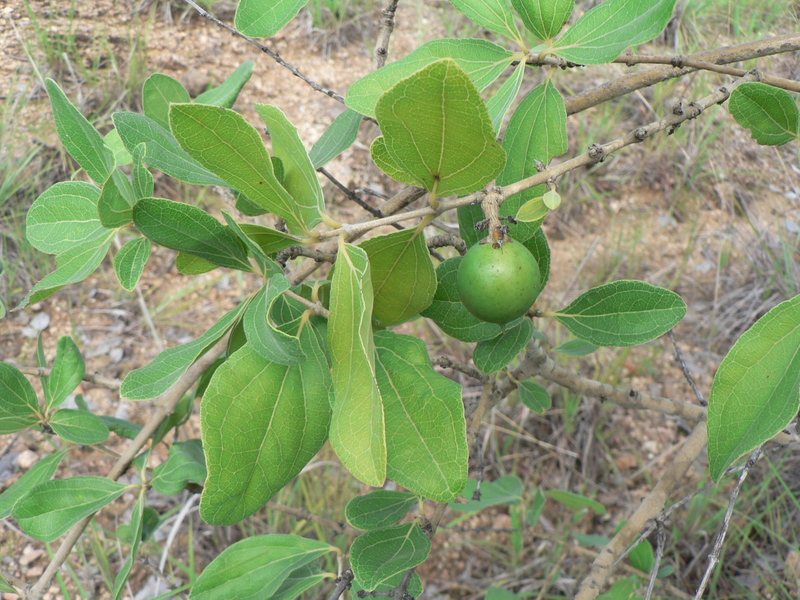Strychnos innocua

|
|
Strychnos innocua Common Names: Powder-bark monkey-orange, Green
monkey-orange Scientific Classification Kingdom: Plantae Clade: Tracheophytes Clade: Angiosperms Clade: Eudicots Clade: Asterids Order: Gentianales Family: Loganiaceae Genus: Strychnos Species: S. innocua Synonyms: Strychnos alnifolia Baker, Strychnos dschurica (Gilg) A.Chev., Strychnos huillensis Gilg & Busse, Strychnos penduliflora Baker, Strychnos unguacha A.Rich. Morphological Description Strychnos innocua is a deciduous shrub or small tree, typically 2–12 meters
tall, occasionally reaching 18 meters, with a low-branching bole 7–40 cm in
diameter. Its key characteristics include: · Bark: Grey to grey-brown, smooth with a powdery surface that rubs
off easily; used medicinally for its bioactive compounds (Burkill, 1985). · Leaves: Simple, elliptic to obovate (4–10 cm × 2–5 cm), dull green,
with pale net-veining; petioles short (2–5 mm) (Fern, 2024). · Flowers: Small, greenish-yellow to cream (5–7 mm), in 2- or
4-flowered axillary clusters; fragrant, blooming seasonally (Prance &
Jongkind, 2015). · Fruit: Spherical berries (4–7.5 cm diameter), bluish-green turning
yellow, with a hard, woody skin; pulp sweet-sour, yellowish, slimy, containing
many seeds (Kew Science, n.d.). Distribution and Habitat Strychnos innocua is widely distributed across tropical Africa, thriving in
diverse ecological niches: · Geographic Range: Native from Côte d'Ivoire to Ethiopia,
south to Angola, Zimbabwe, Mozambique, and Madagascar; common Ascin Nigeria’s
savanna and woodlands (Kew Science, n.d.). · Habitat: Found in deciduous woodlands, open woodlands, rocky hills,
and riverine areas; prefers well-drained, sandy or loamy soils (pH 5.5–7.0)
with annual rainfall of 600–1,500 mm; occurs from sea level to 1,600 m (Fern,
2024). · Ecological Role: Contributes to savanna biodiversity;
fruits are consumed by birds and mammals, aiding seed dispersal; supports
pollinators like bees (Burkill, 1985). Ethnopharmacology Strychnos innocua is extensively used in West African traditional medicine,
with pharmacological studies validating several applications (Uttu et al.,
2022): · Antibacterial: In Nigeria, root bark treats gonorrhea. Ethyl acetate root
bark extracts isolated campesterol and β-sitosterol, showing binding affinities
of −7.8 and −7.9 kcal/mol against Staphylococcus aureus and Pseudomonas aeruginosa, respectively, suggesting antibacterial
potential (Uttu et al., 2022). · Antivenom: In Nigeria, root infusions treat snake bites.
Ethnopharmacological surveys confirm its use, though specific studies on
antivenom activity are limited (Uttu et al., 2022). · Antidiabetic Potential: In Cameroon, leaf decoctions are used for
diabetes. While direct studies on S. innocua are scarce, phytosterols like β-sitosterol suggest
antidiabetic properties, as seen in related Strychnos species (Uttu et al., 2022). · Antioxidant: In Ghana, fruit extracts combat oxidative stress. The fruit
pulp contains phenolic compounds, though specific antioxidant studies on S. innocua are limited compared to Strychnos spinosa (Omotayo & Aremu, 2021). · Nutritional and Tonic: In Nigeria, ripe fruit pulp is consumed as
a tonic. The pulp is rich in carbohydrates and micronutrients, supporting its
use for general health, though excessive intake may cause stomach upset due to
trace alkaloids (Fern, 2024). ⚠ Toxicity Profile: Strychnos innocua is generally safe for moderate consumption
of ripe fruit pulp, but other parts pose risks. The seeds and bark may contain
toxic alkaloids like strychnine and brucine, though levels are lower than in
species like Strychnos nux-vomica. Excessive fruit pulp consumption can cause gastrointestinal
distress due to trace alkaloids. Ethanolic leaf extracts were non-toxic
to Artemia salina (LC50:
162.10 µg/ml), but chronic use of bark or seed extracts may elevate liver
enzymes (ALT increased by 10% after 30 days). Use is contraindicated in
pregnancy and for children due to insufficient safety data. Potential heavy
metal contamination in wild-harvested plants requires caution (Neuwinger, 1996;
Omotayo & Aremu, 2021). Phytochemistry The bioactivity of Strychnos innocua is attributed to its phytochemical
profile, though less studied than other Strychnos species (Uttu et al., 2022): · Phytosterols: Campesterol, β-sitosterol, isolated from root bark, with
antibacterial and potential antidiabetic effects (Uttu et al., 2022). · Alkaloids: Trace amounts of strychnine and brucine in seeds and bark,
contributing to toxicity but minimal in fruit pulp (Neuwinger, 1996). · Phenolics: Gallic acid, chlorogenic acid, present in fruit pulp,
supporting antioxidant activity (Omotayo & Aremu, 2021). · Tannins: Found in bark, providing astringent properties for wound
healing (Burkill, 1985). · Saponins: Trace amounts in leaves, potentially aiding antimicrobial
effects (Fern, 2024). Additional Uses · Culinary: Ripe fruit pulp is eaten raw or juiced in Nigeria; leaves
are cooked as a vegetable in West Africa (Fern, 2024). · Timber: Wood is used in Nigeria for construction and tool handles
due to its durability (Burkill, 1985). · Cultural: In Hausa culture, fruit pulp is used in rituals for health
and vitality (Burkill, 1985). · Ecological: Planted in agroforestry to stabilize soils; fruits support
wildlife, enhancing savanna ecosystems (Fern, 2024). References
External Links More Pictures |
|
| Compounds of Strychnos innocua |
|
| References |